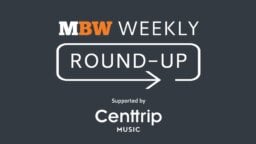The following MBW blog comes from Matt Brinkworth (pictured), who is an artist manager and Head of Digital at Omnian Music Group – home to a record label family including Captured Tracks, Sinderlyn and 2MR. Omnian’s labels are, or have been, home to the likes of Wild Nothing, HOMESHAKE, DIIV, Juan Wauters, Drahla, CULTS, Chris Cohen, Molly Burch, Beach Fossils, Mac DeMarco and more.
Ah, the end of a calendar year. A perfect time for reflection in all areas of life and industry – thoroughly embraced by the music business.
End of year lists canvas music press, labels compile their releases into sales bundles and playlists and Spotify articulates its bulk data on users listening habits in what’s known as Spotify Wrapped.
Spotify first started it’s listening data as engagement marketing campaign in 2015. Aptly titled ‘Your Year In Music’, users were given the ability to view stats on their personal listening history via a purpose-built website and also provided a playlist of their most streamed music.
To bolster the project, the streaming service partnered with global creative agency Stink Studios (formerly Stinkdigital) and accompanied the website with other marketing efforts that made use of the findings available when analysing a years worth of streaming.
This included using location data to, for example, let the residents of Williamsburg, Brooklyn know their zip code had the highest consumption of Justin Bieber’s ‘Sorry’.
Spotify kept the annual initiative going, rebranding it the following year to Spotify Wrapped and extending the data insight to artists themselves, showing artists just how much their music was listened to, by whom, where, what time of day and often with a quirky way of considering it, such as “listeners lost X nights of sleep listening to your music between 1-6 am”.
It’s quickly become a favorite of users and artists alike, to not only dig into this data, but to share it publicly. Of course with public sharing comes public criticism and discourse.
Common complaints by artists, labels and others from the music community that have arisen from the sharing of one’s Spotify Wrapped (which is made very easy by Spotify with direct share to social media buttons) have ranged from it enforcing anti-artistic competitiveness to how it’s just another example of free marketing from artists for a platform that is criticized for low pay-per-stream rates.


These social media objections have also, as expected, been met with counter arguments of unnecessary cynicism and spoiling the fun of artists who are excited to see evidence of their music being enjoyed.
Now, personally I don’t believe that scolding artists and labels who wish to share their data is the right way to further the discussion, however there might just be something Spotify can learn from the outcry.
We all know that streaming and moving away from file ownership-based music platforms has near eradicated music piracy.
Furthermore, the cultural value of music has taken a massive hit as a result of having everything immediately available at a far cheaper price – at a time in music history where artists are more involved, and more cognizant, of exactly where their income is coming from.
“It IS cool, particularly for newer artists, to know that your music is being listened to. It’s just a shame that it does not equate to a proportionate payout. That’s the elephant in the room that we’re now all more than comfortable with talking about.”
With that in mind, it’s fair to understand why some feel emphasizing the level of consumption of an artist’s music, and centering an entire marketing campaign around it, is insulting, when artists and listeners alike have never been more aware of the monetary value, or lack thereof, of each stream.
It doesn’t take much to see why cheerily stating that an artist’s music was streamed “equivalent to X decades of listening” only serves to highlight, and perhaps belittle, the current disparity between music consumption and artist revenue.
There’s a flipside to this, however. Never in the history of music have we had such keen insight into just how much people listen to music. In the past, excluding radio spins, the only metrics we could build our understanding on were physical record sales and later downloads, but once that transaction has occurred and the music is in the hands of the listener.
In those instances, we have no idea whether that vinyl record is listened to until it’s scratched beyond use or snapped on a knee in a bizarre fit of rage before thrown into a burning trash can. You can imagine your own humorous digital equivalents for MP3s.
Maybe others think it’s best not to know, but I certainly think it’s interesting to now be able to see that an album was not just purchased once, but repeatedly listened to, or to be more romantic… loved.
Of course, I’m glossing over stream inflation, passive listening, account hackers and other data skewing occurrences but I’m of the understanding, certainly in the independent sector, that that’s less impactful than you may think.
It IS cool, particularly for newer artists, to know that your music is being listened to. It IS fun to have that articulated in a way that blows your mind, like the geographical spread of your listeners would require “an AUX cord stretching X miles”.
It IS ok to be excited enough to want to share that information. It’s just a shame that it does not equate to a proportionate pay out that, when considered, can spoil the idea completely. That’s the elephant in the room that we’re now all more than comfortable with talking about.
The industry misses the popularity of physical and download sales because of the far greater upfront (one time) payment at the expense of further insight. It’s unfortunate that we can only seem to have one or the other.
As Apple enters the arena with ‘Apple Music Replay’ and Deezer roll out ‘#MyDeezerYear’, their own answers to Spotify Wrapped, it’s obvious that music streaming data and it’s visualization is only going to become more and more utilized as a marketing tool, whilst the per stream rates of platforms continue to drop.
If digital service providers want to push their consumption data to the forefront every year they will have to expect an ever growing protest of what the numbers actually mean to artists.

You can follow Matt, or share your Spotify Wrapped with him, on Twitter at @brnkwrth
Music Business Worldwide






